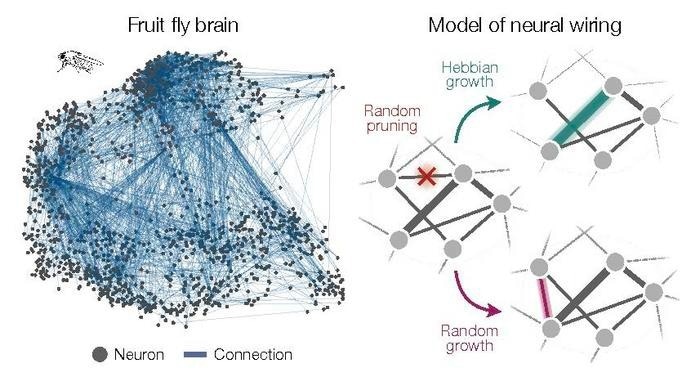In a seminal study featured in Nature Physics, researchers from institutions including the CUNY Graduate Center Initiative for the Theoretical Sciences and Yale University have uncovered a universal principle behind the formation of robust neural connections in the brain, known as "heavy-tailed" connections. Their mathematical model, applicable across different species, suggests these critical connections emerge from a mix of specific neuronal interactions and random dynamics, offering new insights into brain structure and function.
 (Left) Network of the strongest connections among over 20,000 neurons in the fruit fly brain. (Right) Model of network formation. Some random connections are pruned, while other connections become stronger through a mixture of Hebbian and random growth. Image Credit: Christopher Lynn.
(Left) Network of the strongest connections among over 20,000 neurons in the fruit fly brain. (Right) Model of network formation. Some random connections are pruned, while other connections become stronger through a mixture of Hebbian and random growth. Image Credit: Christopher Lynn.
However, within these networks, a minority of neurons possess significantly stronger connections to each other than the rest. These unusually robust connections, termed "heavy-tailed" based on their distribution shape, are believed to have a disproportionately significant impact on brain function.
For quite some time, researchers have pondered how neural networks undergo reorganization to establish these uncommon connections and whether the process of their formation is specific to certain species or governed by a more fundamental shared principle.
To understand these very strong connections between neurons, you can think of a social network: Some connections, like those with your best friends and family, are much stronger than most, and these are very important in the network. Until recently, we didn’t have a way of teasing out the mechanism by which these rare connections come together, but advances in particular forms of microscopy and imaging now allow us to take a peek into how it happens.”
Christopher Lynn, Study First Author and Assistant Professor, Physics, Yale University
Christopher Lynn was a postdoctoral fellow in the ITS program.
To investigate, the researchers scrutinized extensive, openly accessible datasets detailing the neural connections in fruit flies, mice, and two worm species (C. elegans and Platynereis). This compiled data, acquired through volume electron microscopy and high-throughput image processing, facilitated a comparative analysis of networks across multiple species. The aim was to identify commonalities and distinctions in forming heavy-tailed connections.
The scientists formulated a mathematical model to elucidate the hypothetical rearrangement of neural wiring that gives rise to these robust connections. Drawing from a long-established neuroscience mechanism known as Hebbian plasticity, which posits that neurons wire together when they fire together, the researchers demonstrated that this principle leads to forming the observed heavy-tailed connections.
Furthermore, when neural activity was incorporated into the model, another crucial aspect of neural network structure emerged: clustering, indicating the propensity for neurons to form closely interconnected groups.
Our model was based on the assumption that neurons rearrange and connect under a mixture of Hebbian and random dynamics.”
Christopher Lynn, Study First Author and Assistant Professor, Physics, Yale University
Lynn observed that neurons occasionally form connections for specific reasons, while the connections occur randomly at other times. The model developed by the research team demonstrated its applicability across species, illustrating how fundamental and universal principles of cellular self-organization can give rise to the robust connections and tightly interconnected networks observed in the brain.
The findings propose that the formation of neuronal networks is not contingent on species-specific mechanisms but may instead be governed by a fundamental principle of self-organization.
This newfound understanding could serve as a crucial groundwork for studying brain structure in various animals and may contribute to a deeper comprehension of human brain function.
Source:
Journal reference:
Lynn, C. W., et al. (2024). Heavy-tailed neuronal connectivity arises from Hebbian self-organization. Nature Physics. doi.org/10.1038/s41567-023-02332-9.